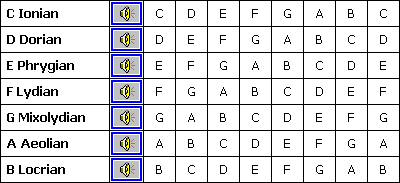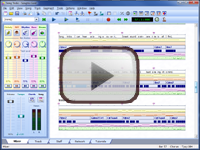(8.4) Introducing Scale Modes
A scale type can result in a whole family of related scale types by using the same pattern of intervals, but starting on each of the other notes, instead of the root note.
This probably sounds pretty strange, so let's go straight to a concrete example, using the C Major scale.
The Major scale is based on pattern of intervals 2-2-1-2-2-2-1, and we have covered this idea in some detail already. If we start from the note C, we are playing a C Major scale, and we get the notes C-D-E-F-G-A-B-C.

If we use these same notes but start with the second note instead of the root note, we have the note sequence D-E-F-G-A-B-C-D, based on a shifted form of the original intervals.

This new sequence of notes is called the Dorian mode of C Major, or we can think of it as being a scale type of its own, and call it D Dorian.
In fact, we can arrange the notes of the Major scale in seven different ways, by starting on each of the other notes. Each of these is a different mode of the Major scale, and each has a special name.
Here are all the modes of the C Major scale.

The names of the modes are based on ancient Greek place names, and were first used with early choral music, such as Gregorian chants. For this reason, they are also sometimes referred to as the church modes.
Playing a scale in different modes is similar to playing a chord in different inversions. Each mode is a synonym scale of the other modes. They are all based on the same set of notes, but in a different order, which gives each mode a different melodic flavour.
What we have simply called the Major scale up until now is known as the Ionian scale within this system. There is also another mode that we have come across already - the Aeolian scale, otherwise known as the Natural Minor scale.
You may recall that the Natural Minor scale is a useful interpretation of the Major scale for applying to music with a minor flavour.
In the same way, the other modes provide other ways to interpret the Major scale, making it better suited to other harmonic settings. Read on, and all will be explained.

Most ChordWizard products contain the Scale Synonyms tool. This identifies and allows you to explore scale modes, and symmetric scale types which produce identical sets of notes.
|
Topic 99 of 117
| ||
Bring these music concepts to life with the free Songtrix Bronze Edition as you create songs from chords and scales.
Then publish and share your ideas with the other musicians you meet on the ChordWizard Network.
Have questions? Join the ChordWizard Network and post them in the Music Theory forum for answers and discussions on your topics of interest.








